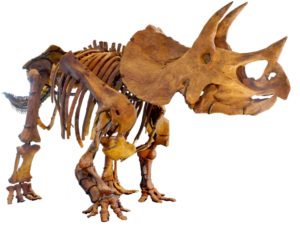Dinosaurs on the Ark
Job 40:15 “Behold now behemoth, which I made with thee; he eateth grass as an ox.”  Part of our problem in understanding dinosaurs is the fact that the term does not mean a great deal. In the 19th Century, as fossils were being discovered of large reptilian-type creatures, it was felt that an all-encompassing term would be needed with which to label them. That term was supplied by Sir Richard Owen, founder of London’s Natural History Museum. As many other fossils of extinct creatures were discovered, a word was needed for all such extinct animals – and the word Owen chose was dinosaur – terrible lizards. As more dinosaur fossils were discovered, their discoverers exercised their rights to have their specimens named the way that they wanted. The problems arise when similar looking fossils are discovered. Are these different species? Are they simply young and old specimens of the same species? Given, also, that many dinosaur fossils are frankly incomplete, even comprising just a minority of necessary bones, the confusion and the possibility of duplications abound. It has been estimated, even by evolutionists, that less than half the named dinosaurs are, in fact, unique species. For creationists, the most important unit of classification is not even the species, but the kind. God created animals to reproduce according to their kinds. A kind is a much broader term than a species. Given the over-classification of dinosaurs, it is likely that there are only 50 kinds of dinosaurs in the world. Some are big, but some are very small, and the average size is that of a sheep. Therefore, it is likely that Noah was sent 100 creatures by God, that we would now call dinosaurs, along with the other animals. Author: Paul F. Taylor We know, Lord, that Your word is true. We thank You that, as we seek to understand Your Scriptures, bit by bit, our understanding of these and other animals increases. Amen. Ref: Catchpoole, D. (2009), Too Many Dinosaur Names, < https://creation.com/too-many-dinosaur-names >, accessed 5/2/2018. Image: Allie Caulfield, Creative Commons Attribution-Share Alike 3.0 Unported.
Part of our problem in understanding dinosaurs is the fact that the term does not mean a great deal. In the 19th Century, as fossils were being discovered of large reptilian-type creatures, it was felt that an all-encompassing term would be needed with which to label them. That term was supplied by Sir Richard Owen, founder of London’s Natural History Museum. As many other fossils of extinct creatures were discovered, a word was needed for all such extinct animals – and the word Owen chose was dinosaur – terrible lizards. As more dinosaur fossils were discovered, their discoverers exercised their rights to have their specimens named the way that they wanted. The problems arise when similar looking fossils are discovered. Are these different species? Are they simply young and old specimens of the same species? Given, also, that many dinosaur fossils are frankly incomplete, even comprising just a minority of necessary bones, the confusion and the possibility of duplications abound. It has been estimated, even by evolutionists, that less than half the named dinosaurs are, in fact, unique species. For creationists, the most important unit of classification is not even the species, but the kind. God created animals to reproduce according to their kinds. A kind is a much broader term than a species. Given the over-classification of dinosaurs, it is likely that there are only 50 kinds of dinosaurs in the world. Some are big, but some are very small, and the average size is that of a sheep. Therefore, it is likely that Noah was sent 100 creatures by God, that we would now call dinosaurs, along with the other animals. Author: Paul F. Taylor We know, Lord, that Your word is true. We thank You that, as we seek to understand Your Scriptures, bit by bit, our understanding of these and other animals increases. Amen. Ref: Catchpoole, D. (2009), Too Many Dinosaur Names, < https://creation.com/too-many-dinosaur-names >, accessed 5/2/2018. Image: Allie Caulfield, Creative Commons Attribution-Share Alike 3.0 Unported.